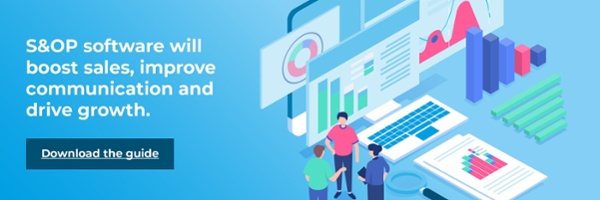Increased costs, inventory issues, supply chain complexity and more are all potential issues you might face as the supply chain evolves to meet new consumer and business demands - so what’s the answer?
The right supply chain management solution can help you plan ahead and become a more efficient business. Let’s explore the challenges supply chain management software can solve and the impact these can have on your business.
The challenges of supply chain management
Supply chain management software is essentially the one-stop-shop for increased connectivity, accurate reporting, forecasting and real-time analytics. Best in class software can manage inventory, logistics, balance supply and demand and update key financial statements.
Think of it as the software that controls a complex train station with multiple carriages and tracks. It can see trains coming, going and develop strategies for the most efficient timetables. But let’s forget the train analogy and focus on the challenges of supply chain management.
The varying costs within a supply chain
A major challenge for the management of a supply chain is dealing with increasing costs, putting your profit margins under pressure. Increases come from multiple sources across the supply chain - the increased price of raw materials, labour, overseas tariffs and other logistics costs. Added to this, changes to the economic environment are constant.
The way supply chain management software can plan for these changes is through increased visibility, accountability and transparency across your entire network.
Through the collection of accurate data from internal and external sources and the alignment of all your departments and their relative budgets, you’ll be able to plan for these eventualities and act appropriately.
Multiple market channels and supply chain complexity
Supply chains must adapt to the ever-changing market routes that consumers buy from. Each supply chain process will need increasingly elastic properties to be able to deal with alterations to these channels.
Supply chain management software will help to supply this elasticity to the following areas:
- The fast last-mile delivery and logistics of eCommerce websites.
- Accurate inventory control.
- The understanding of fulfilment options and close alignment with third-party marketplaces.
- Visibility across multiple market channels and their specific conditions and vested interests.
- Focus on customer experience and tailored individualisation.
The pressures that come from risk
The supply chain is affected by multiple different factors. Environmental changes, international relationships, trade disputes and various economic pressures can all turn into risks.
For example, you may find that due to political issues, coordination and management of suppliers and manufacturers are affected, directly hitting your profit margins. You could experience issues of siloed data, decreasing visibility across all your channels that hurt the accuracy of your reporting and decision-making.
Supply chain management software can help reduce this issue by bringing together different aspects of your business. You'd then gain real-time visibility to help with data forecasting and strategic business planning.
Supply chain volatility
One pressure that comes from developing and maintaining a supply chain is the volatility and complexity of international relationships and evolving protectionism. For example, changes to tariffs over trade routes can result in additional fees and possible delay times.
The supply chain can also be affected by:
- Port congestion, loading times and operation charges.
- Shortage of long-haul drivers and trucking capacity.
- International shipping problems.
By taking advantage of the latest supply chain technology, managers will have the advantage of being able to understand these issues, predict them and create robust plans that help to minimise the impact.
Inventory mismanagement
Availability and costs are always liable to change. Retailers prefer to move through inventory faster with their money being held up in high-speed, attractive products, rather than slow-moving ones. This requires a faster upstream supply chain management. Supply chain management software will be able to plan for these changes.
Issues with products
Sales and marketing cycles are likely to affect consumer demand for products and services. For products, these demands must be forecast accurately, with the effects detailed in any supply and manufacturing processes.
Newer products will require fast development and prototyping. Your supply chain must be quick and efficient for it to quickly and reliably bring a product to market.
What to consider before implementation
You might notice a recurring theme here - introducing supply chain management software to improve visibility. But it's not just about putting one in place.
You need to consider all the branches, departments and processes of your business, and how they are likely to be impacted by the implementation of supply chain management software.
Each phase of implementation needs to be appropriately scheduled and completed in a timely fashion, allocating enough time to properly introduce each department to its effects. This will aid in gradually building your ROI through increased efficiency across all teams, rather than dropping a new technology at your colleagues’ feet and expecting them to utilise it straight away.
Before implementation, explain what the supply chain management software will achieve and ask your teams to explore the issues they face and their specific needs. What are their requirements?
Furthermore, in the case of some software, you can choose between on-premise or cloud-based solution. If you have an in-house team who will be there to manage the software and provide ongoing support, then on-premise may be an option. If you’re looking for something faster to implement, with a lower investment and ongoing cost of ownership, then a cloud solution is a good choice.
The benefits of supply chain management software once it’s up and running
With all the challenges we’ve mentioned, it’s now time to show you how you can overcome them with supply chain management software.
This type of software is constructed with many innovative features. It includes interactive statistical forecasting, segmentation analysis, data integration and other much-needed digital processes such as product lifecycle planning, reporting, analytics and data maintenance.
The benefits of a supply chain management software and its features are multiple.
Effective stock management
Imagine a piece of software that can track your stock and even predict, based on historical data, when you’ll need new stock and the amounts. Supply chain management software can predict for seasonality, trade promotions and other factors that stimulate customer demand.
Accurate forecasting
This type of software will take your critical data, the information you’ve gathered from internal and external sources on opportunities and transform it into a sales management tool.
It will employ machine learning and AI capabilities to transform your data into recommendations, and scenario analysis will provide you with multiple courses of action, with much greater certainty of outcome.
Logistics cost reduction
By aligning your supply chain and balancing customer and market demand with internal capacity, you can reduce costs and achieve greater efficiency. By forecasting demand more accurately you can ensure stock is in the right place at the right time, avoiding stockout and missed sales opportunities.
Improved visibility and collaboration
Overall, this software should be user-friendly. The best kind of supply chain management software will work in a way that increases the chances of collaboration by universalising your company’s internal processes and reporting.
By putting this complex process onto a single platform, your colleagues will be able to share data in real-time over multiple devices.
It should also be software developed with the idea that not everyone knows how to code, which makes it a lot more accessible.
While these are important benefits, they’re not the only ones:
- Universalised software enhances intra-department communication and collaboration.
- A defined and visible process achieves greater business continuity.
- Response and reaction time is increased.
- Greater time management effectiveness - Proper utilisation of a supply chain management software can turn a two-week process into a two hour one.
- Accurate forecasting will decrease company spends by focusing on what you need, where and when you need it.
- Infrastructure can be optimised.
- A decrease in lost sales.
There have even been cases where organisations who utilise supply chain management software have taken four to six days of inventory from the supply chain.
An effective supply chain process, where visibility, transparency and efficiency are championed, isn’t just about benefiting one involved party. Through the use of this software, benefits are delivered to all supply chain participants due to the increased connectivity between those involved.
This includes those organisations who supply your raw materials, your manufacturers, your retailers and even the end consumers.
Improved visibility in Finance
With better connected real-time analytics within supply chain processes, Finance departments can benefit by linking this data directly to key financial statements. They’re able to update P&L statements, balance sheets and cash flow statements automatically in real-time. This gives Finance latest position statements without having run a process - it's there all the time.
Improved customer experience
A result of all the above benefits is that the overall customer experience is better. If your platform is effective, your teams are aligned and your data is shared, your business is able to delight customers with both speed and reliability.
With the challenges of supply chain, the benefits of supply chain management software and the need for increased cohesion within your business processes, it might be time to start searching for the perfect solution for you.
Discover the best sales & operational planning software for your business
Effective supply chain management is a large part of your overall Sales & Operation Planning (S&OP) campaigns. But only the best operations and logistics can be achieved with the right S&OP software.
We’ve developed a useful guide you can use to discover the benefits and information surrounding S&OP software. It also includes the features you should look out for and tips on choosing the perfect one for you.
Click the link below to download today.




